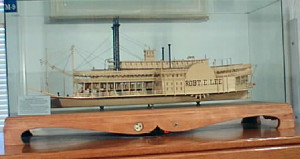ROBERT E. LEE
The Ship The hull was designed by Ed Witt Hill. The ship was built by Hill, Roberts & Company, New Albany, Indiana, in 1866 for Captain John W. Cannon at a cost of $200,000. It was built to run between Vicksburg, Mississippi, and New Orleans, Louisiana, carrying 6,000 bales of cotton without spoiling the view of the boiler-deck passengers. On June 30, 1870, New Natchez, with Captain Thomas P. Leathers, and Robert E. Lee, both bound for St. Louis, left within four minutes of each other, with Robert E. Lee ahead. Robert E. Lee arrived in St. Louis six hours and 33 minutes ahead on July 4th. The time was three days, 18 hours and 14 minutes, a record time up to that date, and never surpassed. In 1876, she was dismantled at Howard Shipyard in Jeffersonville, Indiana, and much of her outfit and equipment used in building a new and bigger Robert E. Lee. The Model This was a different kind of a model for Marple. As he noted, “It had to be built from the bottom up and from the inside out.” The hull is made of white holly; the stern is tapered to a flat, square and narrow edge to allow a small flat rudder to fit snugly against the stern, just clearing the lowest part of the ship to give clearance in case of a sand bar. The main deck is planked in teak. More than any other ship model, a river-boat must be done from the inside out and bottom to the top, making sure that all center work is done first, before trying to finish the sides. Marple made the engines just to see if he could, knowing they would be almost impossible for anyone to see. The engines are made of ebony and brass, and the pitman drive shafts go from the engines to the paddle wheel. Each engine drove each paddle individually and had to be made this way. They have connecting rods into the engine to hook on the pitmans and into the crank shaft on the paddle wheel. All that is needed is the steam to make the paddle wheels move; with no steam, they can be hand-moved. The boilers are made of eight round ebony rods, fastened to the face of the boiler. Below each boiler is a door that can be opened to fire up steam. Around all this was built a shield to protect the boat from the heat. Steam pipes of brass tubing, blackened, ran the steam into the two engines. A U-shaped flue then runs up to where the smoke stacks would later go. There is even a wood storage area for kindling and wood for the engines. The paddle wheels are complete with five paddles, each with a copper band, joined to make ten paddles of five paddles on each wheel which will turn either by moving the engine on the inside or by touching the wheel itself to give it movement. The grand staircase in the front has a mail room at one side and storage room at the other side. It is lit by two flood lights. It leads up into the grand ballroom. Each cabin door is made individually, including the windows in the doors and the transom above. The upper deck is planked in amaranth (purple heart) for the color. Here you can see the calliope. Marple used ebony for the black keys. The bell on the skylight roof is in a brass holder. The bell was turned of brass, will actually swing and has a clapper in it. There are three life boats, two set on the main deck on each side. The model has 40 rice grain lights, each one made able to be changed. Plank on frame construction by Ed Marple circa 1960 Case: H 16” L 36” W 10 ¼”

